Can Apple win its iPhone 4S bet that 4G isn't ready for masses?

Apple's launch of the iPhone 4S was notable for its new features---better camera, Siri voice activation, iOS 5 and iCloud---but what the device was missing in 4G capability got just as much attention.
Tim Cook, CEO of Apple, has said that new speedy networks such as the ones operated by Verizon and AT&T soon require too many design compromises. That's statement is a diplomatic way to say that Apple wasn't willing to bulk up the iPhone to support the chips required to support 4G. Apple also doesn't want battery life to disappear in a few hours.
Given those 4G drawbacks---combined with the reality that coverage can be spotty---it's no surprise that the iPhone 4S lacked 4G capability.
For Apple, the bet is that design trumps bleeding edge technology. That bet was a no-brainer at the beginning of the year and given current technology Apple's decision will work for now. Apple is also betting that its set-up with the iPhone 4S can deliver 4G speeds over a 3G network.
iSuppli's Francis Sideco noted:
With the speeds the iPhone has attained with the existing 3G standard known as High-Speed Packet Access (HSPA), there is no appreciable benefit to adopting LTE, especially given the current spectrum and uplink speed constraints for LTE. Apple declined to offer an LTE-enabled iPhone that would have been more expensive, larger and more power hungry—and instead opted to introduce a device that delivers nearly the same wireless data speed, but with a superior user experience.
CNET News's Brooke Crothers noted that Apple is saving the iPhone 5 for LTE. Apple is apparently waiting for slimmer Qualcomm chips that can handle both 3G and 4G. Without those Qualcomm chips, expected in the second quarter of 2012, Apple would have to design an SUV-sized device. There's a reason that LTE devices like the Motorola Droid Bionic and HTC Thunderbolt are so damn big---they have to pack LTE and 3G chips.

In other words, Apple made a logical design choice by keeping the iPhone 4S LTE free.
The Great Debate: iPhone Yes vs. iPhone No | ZDNet iPhone coverage | CNET iPhone event coverage |
So what's the problem? If you buy into the iPhone 4S it requires a two-year contract with a carrier. At Verizon, you'd have to assume that LTE coverage won't get better over the next 24 months. At AT&T you have a little more wiggle room.
In our Great Debate, Jason Perlow summed the LTE argument up well:
I believe a large portion of Business users that have been in exit mode from BlackBerry will not find any of the current iPhones as attractive as they could have been had they been launched with 4G. There's something to be said for 8+ megabits per second wireless tethering from your hotel on the road from your business laptop or tablet that you can get on a Droid Bionic that you cannot get on an iPhone 4S, a 4 or a 3GS.
It's unclear whether the no-LTE bet pays off 12 months from now should Apple go that long without an iPhone 5.
Will the Motorola Droid Bionic benefit from an LTE-free iPhone 4S?
My buying calculus---I have a contract that's up in November---is already rattled a bit. Here are my moving parts:
- I have LTE Mi-Fi and the speeds are awesome when there's coverage. On a moving train, the downshift from LTE to 3G is brutal. Overall, I've found LTE to be disappointing relative to my obviously too lofty expectations going in.
- I fully expect Verizon's LTE coverage to improve over the next 24 months.
- Android, my current mobile operating system, is wearing thin on my patience. If you're the type of person that loved MS-DOS prompts then Android may be for you. I don't have the time to tinker and just want things to work. My daughter's iPod Touch reveals an OS that's much snappier.
- I'm not a fan of the LTE handsets on the market today. First, they are pricey at two-year contract rates. And it doesn't help that these devices are huge. It's not like I'm petite or anything, but really don't want a cinderblock in my pocket.
- Now if I go with an iPhone 4S, it's quite possible I'll be feeling downright slow by time I can upgrade.
Add it up and I'm stuck in smartphone limbo. It's a pretty safe bet that there are other Verizon customers in the same boat. Overall, Verizon customers will have to decide whether the network means more than the design. Apple's bet is that you'll go with the design and a few newfangled voice features. My hunch is that Apple's bet will pay off, but things could get dicey late in 2012.